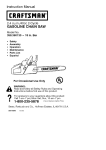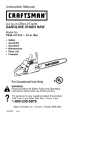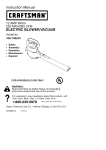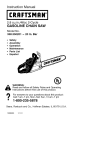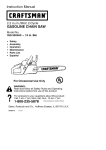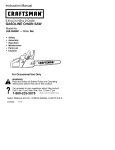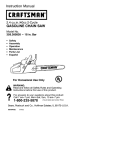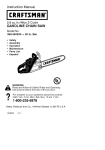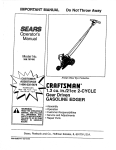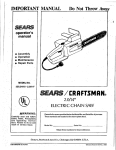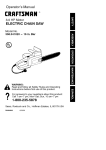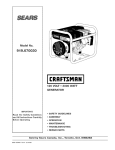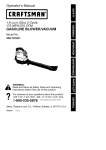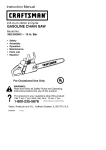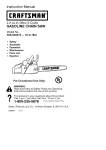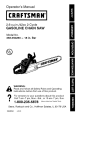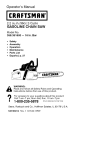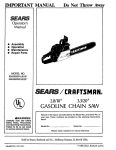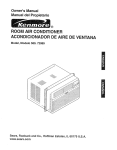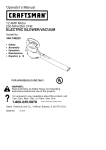Download Craftsman 358.360170 Instruction manual
Transcript
Instruction
Manual
2.6 cu.in./42cc 2-Cycle
GASOLINE
CHAIN SAW
Model No.
358.360170
•
- 18 in. Bar
Safety
• Assembly
•
•
Operation
Maintenance
•
Parts List
•
Espar_ol
For Occasional
&
WARNING:
Read and follow all Safety Rules and Operating
Instructions
before first use of this product.
For
Call answers
7 am-7
•
to your
questions
this product:
pm,
Mon-Sat;
Sun,about
10 am-7
pm
1-800-235-5878
Sears, Roebuck
530163125
Use Only
7/10/02
and Co., Hoffman
_Hoo,o,isted areCentraITime)
Estates,
IL 60179 U.S.A.
Warranty
Safety Rules
Assembly
Operation
Maintenance
Service and Adjustments
2
2
6
7
13
16
FULL ONE YEAR WARRANTY
Storage
Troubleshooting
Table
Emissions Statement
Parts List
Spanish
Parts & Ordering
ON CRAFTSMAN
19
20
21
23
26
Back Cover
_ GAS CHAIN SAW
For one year from the date of purchase, when this Craftsman Gas Chain Saw is
maintained, lubricated and tuned up according to the instruction manual, Sears
witl repair, free of charge, any defect in material or workmanship.
This warranty excludes the bar, chain, spark plug and air filter, which are
expendable parts, and become worn during normal use.
If this Gas Chain Saw is used for commercial or rental purposes, this warranty
applies for 30 days from the date of purchase,
WARRANTY SERVICE IS AVAILABLE BY RETURNING THIS CHAIN SAW TO THE
NEAREST SEARS STORE OR SERVICE CENTER IN THE UNITED STATES
This warranty gives you specific legal rights, and you may also have other rights
which vary from state to state,
Sears, Roebuck and Co., D/817 WA, Hoffman Eotateo, IL 60179
_LWARNING:
Always disconnect
spark plug wire when making repairs
except for carburetor adjustments. Because a chain saw is a high-speed
woodcutting tool, special precautions
must be observed to reduce risk of accidents. Careless or improper use of
this tool can cause serious injury.
PLAN AHEAD
• Restrict the use of your saw to adult
users who understand and can follow the safety rules, precautions,
and operating instructions found in
this manual.
Hearing
Protection
Snug
_
_
A
I u'II'_
Fitting _
Clothing
•
•
•
Safety Hat
Eye
Protection
•
Heavy Duty
Gloves
Safety
Shoes
_N
•
• Wear protective gear. Always use
steel-toed safety footwear with non-slip
soles; snug-fitting clothing; heavy-duty,
2
non-slip gloves; eye protection such
as non-fogging, vented goggles or
face screen; an approved safety hard
hat; and sound barriers (ear plugs or
mufflers) to protect your hearing. Regular users should have hearing
checked regularly as chain saw noise
can damage hearing.
Secure hair above shoulder length. Do
not wear loose clothing or jewelry; they
can get caught in moving parts.
Keep all parts of your body away
from the chain when the engine is
running,
Keep children, bystanders, and animals at least 30 feet (10 meters)
away from the work area when starting and using the saw.
Do not handle or operate a chain saw
when you are fatigued, ill, or upset, or
if you have taken alcohol, drugs, or
medication. You must be in good
physicat condition and mentally alert. If
you have any condition that might be
aggravated by strenuous work, check
with doctor before operating.
Do not start cutting until you have a
clear work area, secure footing, and
especially if you are felling a tree, a
retreat path.
OPERATE
YOUR
SAWSAFELY
• Do not operate with one hand. Serious injury to the operator, helpers, or
bystanders may result from onehanded operation. A chain saw is intended for two-handed use,
• Operate the chain saw only in a weltventilated outdoor area.
• Do not operate saw from a ladder or
in a tree.
• Make sure the chain will not make
contact with any object while starting
the engine. Never try to start the saw
when the guide bar is in a cut.
• Do not put pressure on the saw, especially at the end of the cut. Doing
so can cause you to tose control
when the cut is completed,
• Stop engine before setting saw down.
• Hand carry saw only when engine is
stopped. Carry with muffler away
from body; guide bar & chain projecting behind you; guide bar preferably
covered with a scabbard.
• Do not operate a chain saw that is
damaged, improperly adjusted, or not
completely and securely assembled.
Always replace bar, chain, hand
guard, chain brake, or other parts immediately if they become damaged,
broken, or are otherwise removed.
MAINTAIN
YOUR
SAW tN GOOD
WORKING ORDER
• Have all chain saw service performed by a qualified sei_/ice dealer
except the items listed in the MAINTENANCE section of this manual
• Make certain the saw chain stops
moving when the throttle trigger is
released. For correction, refer to
CARBURETOR ADJUSTMENTS.
• Keep the handles dry, clean, and
free from oil or fuet mixture.
• Keep caps and fasteners securely
tightened.
• Nonconforming replacement components or the removal of safety devices
may cause damage to the unit and
possible injury to the operator or bystanders. Use only Craftsman accessories and replacement parts as recommended. Never modify your saw.
• Maintain chain saw with care,
• Keep unit sharp and clean for better
and safer performance.
• Follow instructions for lubricating and
changing accessories.
• Check for damaged parts. Before further use of the chain saw, a guard or
other part that is damaged should be
carefully checked to determine that it
witl operate properly and perform its
intended function. Check for alignment
of moving parts, binding of moving
parts, breakage of parts, mounting and
any other conditions that may affect its
operation. A guard or other part that is
damaged should be properly repaired
or replaced by a Sears Service Center
unless otherwise indicated elsewhere
in the instruction manual.
• When not in use, chain saws should
be stored in a dry, high or locked-up
place out of the reach of children.
• When storing saw, use a scabbard or
carrying case.
HANDLE FUEL WITH CAUTION
• Do not smoke while handling fuel or
while operating the saw.
• Eliminate all sources of sparks or
flame in areas where fuel is mixed or
poured.
• Mix and pour fuel in an outdoor area
and use an approved, marked container for all fuet purposes. Wipe up
all fuel spills before starting saw.
• Move at least 10 feet (3 meters) from
fueling site before starting.
• Turn the engine off and let saw cool
in a non-combustibIe
area, not on
dry leaves, straw, paper, etc. Slowly
remove fuet cap and refuel unit.
• Store the unit and fuel in a coot, dry
well ventilated space where fuel vapors cannot reach sparks or open
flames from water heaters, electric
motors or switches, furnaces, etc.
GUARD AGAINST KICKBACK
Follow alI safety rules to help avoid
kickback and other forces which can
result in serious injury.
Clear The Working
Area
dlBIWAHNING:
Avoid kickback which
can result in serious injury. Kickback
is the backward, upward or sudden forward motion of the guide bar occurring
when the saw chain near the upper tip
of the guide bar contacts any object
such as a log or branch, or when the
wood closes in and pinches the saw
chain in the cut. Contacting a foreign
object in the wood can atso result in
Ioss of chain saw control.
• Rotational Kickback
can occur
when the moving chain contacts an
object at the upper tip of the guide
bar. This contact can cause the
chain to dig into the object, which
stops the chain for an instant. The
result is a lightning fast, reverse
reaction which kicks the guide bar up
and back toward the operator.
• Pinch-Kickback
can occur when the
the wood closes in and pinches the
moving saw chain in the cut along the
top of the guide bar and the saw chain
is suddenly stopped. This sudden
stopping of the chain resutts in a reversal of the chain force used to cut
wood and causes the saw to move in
the opposite direction of the chain
rotation. The saw is driven straight
back toward the operator.
• Pull-In can occur when the moving
chain contacts a foreign object in the
wood in the cut along the bottom of
the guide bar and the saw chain is
suddenly stopped. This sudden stopping pulls the saw forward and away
from the operator and could easily
cause the operator to lose control of
the saw.
REDUCE THE CHANCE OF
KICKBACK
• Recognize that kickback can happen.
With a basic understanding of kickback, you can reduce the element of
surprise which contributes to accidents.
• Never let tile moving chain contact
any object at the tip of the guide bar.
• Keep working area free from obstructions such as other trees, branches,
rocks, fences, stumps, etc. Eliminate
or avoid any obstruction that your saw
chain could hit while cutting.
• When cutting a branch, do not let the
guide bar contact another branch or
other objects around it.
• Keep saw chain sharp and properly
tensioned. A loose or dutI chain can
increase the chance of kickback. Foltow manufacturer's chain sharpening
and maintenance instructions. Check
tension at regular intervals, but never
with engine running. Make sure chain
brake nuts are securely tightened.
• Begin and continue cutting at full
speed. If the chain is moving at a
slower speed, there is greater chance
of kickback occurring.
• Use extreme caution when reentering
a cut.
• Do not attempt cuts starting with the
tip of the bar (plunge cuts).
• Watch for shifting logs or other forces
that could close a cut and pinch or fall
into chain.
• Use the specified Reduced-Kickback
Guide Bar and Low-Kickback Chain.
Avoid Pinch-Kickback:
• Be extremely aware of situations or
obstructions that can cause material
to pinch the top of or otherwise stop
the chain.
• Do not cut more than one tog at a
time.
• Do not twist saw as bar is withdrawn
from an undercut when bucking.
Avoid Pult-ln:
• Always begin cutting with the engine
at full speed and the saw housing
against wood.
• Use wedges made of plastic or wood.
Never use metal to hold the cut open.
MAINTAIN CONTROL
Stand to the teft of the saw
Thumb on
underside
of h_
Elbow
locked
Never reverse band positions
• A good, firm grip on the saw with both
hands wilI help you maintain control.
Don't let go. Grip the rear handle with
your right hand whether you are right
or left handed. Wrap the fingers of
your left hand over and around the
front handlebar, and your left thumb
under the front handlebar. Keep your
left arm straight with the elbow locked.
• Position your left hand on the front
handlebar so it is in a straight Iine with
Low-Kickback
Chain
yourright
handontherearhandle
Contoured Depth Gauge
when
making
bucking
cuts.
Stand
stightty
totheleftsideofthesawto
deflects kickback
keep
yourbody
frombeing
inadirect
force And allows
_ine
withthecutting
chain.
_._
longated
Guard Link
wood
to gradually
• Stand
withyourweight
evenly
balride into Cutter
anced
onboth
feet.
• Donotoverreach.
Youcould
bedrawn CHAIN BRAKE
orthrown
offbalance
andlosecontrol • Chain Brake: designed to stop the
chain in the event of kickback.
• Donot
ctomaintain
utabove
shoulder
height,
ttis
difficult
control
ofsaw
f_
above
shoulder
height.
aWARNING:
WE DO NOT REPKICKBACK
SAFETY
FEATURES RESENT AND YOU SHOULD NOT AS-
,_
WARNING:
The foIIowing features
are included on your saw to help reduce
hazard of kickback; however, such features wi}I not totally eliminate this danger.
Do not rety only on safety devices. FoF
Iow aII safety ru_es to help avoid kickback and other forces which can result
tn serious injury,
• Front Hand Guard: designed to reduce
the chance of your teft hand contacting the chain if your hand slips off the
front handlebar.
• Position of front and rear handlebars:
designed with distance between handles and 'in-line" with each other. The
spread and 'in-line' position of the
hands provided by this design work
together to give balance and resistance in controlling the pivot of the
saw back toward the operator if kickback occurs.
• Reduced-Kickback Guide Bar: designed with a small radius tip which
reduces the size of the kickback danger zone on the bar tip. This type bar
has been demonstrated to significantly
reduce the number and seriousness of
kickbacks when tested in accordance
with ANSI
B175,1.
Tip Guide Bar
_
Small Radius
Large Radius
Tip Guide Bar
[
• Low-Kickback Chain: has met kickback performance requirements when
tested on a representative sample of
chain saws below 3.8 cubic inch dispIacement specified in ANSI B175.1.
SUME THAT THE CHAIN BRAKE WILL
PROTECT YOU iN THE EVENT OF A
KICKBACK Kickback is a lightning fast
action which throws the bar and rotating chain back and up toward the operator. Kickback can be caused by allowing contact of the bar tip in the
danger zone with any hard object.
Kickback can aIso be caused by
pinching the saw chain along the top
of the guide bar. This action may push
the guide bar rapidly back toward the
operator. Either of these events may
cause you to lose controt of the saw
which coutd result in serious injury or
even death. DO NOT RELY UPON ANY
OF THE DEVICES BUILT INTO YOUR
SAW. YOU SHOULD USE THE SAW
PROPERLY AND CAREFULLY TO AVOID
KICKBACK. Reduced-kickback
guide
bars and tow-kickback
saw chains reduce the chance and magnitude of
kickback and are recommended.
Your
saw has a low kickback chain and bar
as original equipment.
Repairs on a
chain brake shouid be made by an authorized Sears Service Center. Take
your unit to the place of purchase or to
your nearest Sears Service Center.
• Tip contact in some cases may cause
a lightning fast reverse REACTION,
kicking guide bar up and back toward
operator.
• Pinching the saw chain along the top
of the guide bar may push the guide
bar rapidly back toward the operator.
• Either of these reactions may cause
you to lose control of the saw which
could result in serious injury. Do not
rely exclusively upon safety devices
built into your saw.
ARRESTING SCREEN: Your
SAFETY
NOTICE:
Exposure
tovibra- SPARK
tions
through
prolonged
useofgasoline saw is equipped with a temperature limpowered
hand
tools
coutd
cause
btood iting muffler and spark arresting screen
vessel
ornerve
damage
inthefingers, which meets the requirements of Califorhands,
andjoints
ofpeople
prone
to
nia Codes 4442 and 4443, AII U.S. forcirculation
disorders
orabnormal
swell- est tand and the states of California. Idaing,Probnged
useincoldweather
has ho, Maine, Minnesota, New Jersey,
beenlinked
toblood
vessel
damage
in
and Washington require by taw
otherwise
healthy
people,
tfsymptoms Oregon,
many internal combustion engines
occur
suchasnumbness,
pain,
lossof that
equipped with a spark arresting
strength,
change
inskincolor
ortexture, be
If you operate a chain saw in a
orlossoffeeling
inthef_ngers,
hands,
or screen.
state or locale where such regulations
joints,
discontinue
the
use
ofthis
toot
andseekmedical
attention.
Ananti-vi- exist, you are legatly responsibie for
bration
system
doesnotguarantee
the maintaining the operating condition of
these parts. Faiture to do so is a violaavoidance
ofthese
problems.
Users
whooperate
power
tools
onacontinual tion of the taw. Refer to Customer Reandregutar
basis
must
closety
monitor sponsibilities chart in the MAINTENANCE
their
physical
condition
and
the
conditionsection.
ofthistool.
STANDARDS: This chain saw is tisted
CHAIN
DRAKE:
tfthissawistobe
by Underwriters Laboratories, Inc. in acused
forcommercial
logging,
achain
cordance with American National Stanbrake
isrequired
andshaII
notberedards for Gasoline-Powered Chain
moved
orotherwise
disabted
tocomply Saws Safety Requirements (ANSI
withFederal
OSHA
Regulations
for
B175.1-2000).
Commercial
Logging,
_'L _____.H_
,IllWARNING:
Before using chain
saw, ensure atl fasteners are secure.
CARTON CONTENTS
Check carton contents against the following tist.
Model 358.360170
Chain Saw (fully assembled)
Bar tool
2-cycle engine oil
Carrying case
Extra chain
Gtoves
Bar and chain lube
Examine parts for damage. Do not use
damaged parts.
If you need assistance or find that parts
are missing or damaged, please call
1-800-235-5878.
NOTE: tt is normal to hear the fuel filter
rattle in an empty fuel tank.
Your unit has been factory tested and
the carburetor precisely adjusted. As a
result you may smell gasoline or find a
drop of oil/fuel residue on the muffler
when you unpack the unit.
ASSEMBLY
Your saw is fully assembled;
assembly is necessary.
no
KNOW
YOUR
SAW
READ THIS INSTRUCTION MANUAL AND SAFETY RULES BEFORE OPERATING YOUR
CHAIN SAW. Compare the illustrations with your unit to familiarize yourself with
the location of the various controts and adjustments. Save this manua_ for future
reference.
Chain
Adjustment Toot
(Bar Tool)
Front Hand Guard "_'_
J
Starter Rope
ON/STOP
Switch
Muffler
Chain
Bar Oil Fill Cap
Cy}inder
Fast Idle
Primer
Bulb
Housing
Chain
Direction
of Travel
Rear
Handle
Choke
Knob
Fuel Mix FiII Cap
Cover
Throttte
Lockout
Throttle
Trigger
Front Handle
Chain
Brake
A
Chain
Nuts
Catcher
ON/STOP SWITCH
The ON/STOP SWITCH is used to stop
the engine.
THRO"FrLE TRIGGER
The THROTTLE TRIGGER controIs engine
speed.
THRO'_LE
LOCKOUT
The THROTTLE LOCKOUT must be
pressed before you can squeeze the
throttle trigger. This feature prevents you
from accidentally squeezing the trigger.
FAST IDLE LOCK
The FAST IDLE LOCK holds the throttle
trigger in the starting position. Activate
the fast idle lock by pressing the throttle
lockout and squeezing the throttle trigger. With the throttle trigger squeezed,
press the fast idle lock. Release the
throttle lockout and trigger while holding
the fast idle lock button.
Sprocket
Hole
CHOKE KNOB
The CHOKE KNOB activates the choke to
provide additional fuel to the engine during cotd starting.
PRIMER BULB
The PRIMER BULB circulates fuel to the
carburetor to provide quicker starting.
CHAIN BRAKE
The CHAIN BRAKE is a device designed
to stop the chain if kickback occurs.
The chain brake activates automaticaIly
in the event of kickback. The chain
brake activates manually if the front
hand guard is pushed forward. The
chain brake is disengaged by pulling the
front hand guard back toward the front
handle as far as possible.
CHAIN TENSION
tt is norma_ for a new chain to stretch
during first 15 minutes of operation. You
should check your chain tension frequently. See CHAIN TENSION under the
SERVICE AND ADJUSTMENTS section.
z.,____H._=
4BIJWAHNING:
Muffler is very hot
during and after use. Do not touch the
muffler or allow combustible material
such as dry grass or fuel to do so.
BEFORE
STARTING
41_ WAFINING:
ENGINE
Be sure to read the
fuel handling information in the safety
rules section of this manual before you
begin. If you do not understand the
fuel handling information do not attempt to fuel your unit. Seek help from
someone that does understand the information or catt the customer assistance help line at 1-800-235-5878.
GUIDE BAR AND CHAIN OIL
The bar and chain require lubrication.
The chain oiler provides continuous
Iubrication to the chain and guide bar.
Be sure to fiIt the bar oil tank when you
fill the fuel tank (Capacity = 6.8 ft. oz.).
Lack of oil will quickly ruin the bar and
chain. Too littIe oil wiII cause overheating shown by smoke coming from the
chain and/or discoloration of the bar.
For maximum guide bar and chain life,
we recommend you use Craftsman
chain saw bar oil. If Craftsman bar oit
is not available, you may use a good
grade SAE 30 oil until you are able to
obtain Craftsman brand. The oil output
is automatically metered during operation. Your saw will use approximately
one tank of bar oil for every tank of fuel
mix. Always fill the bar oil tank when
you fill the fuel tank.
FUELING
ENGINE
tt _____._=
4MLWAHNING:
Remove fuel cap
slowly when refueling.
This engine is certified to operate on unleaded gasoline. Before operation, gasoline must be mixed with a good quality
synthetic 2-cycte air-cooled engine oil.
We recommend Craftsman brand synthetic oil Mix gasoline and oil at a ratio
of 40:1. A 40:1 ratio is obtained by mixing 3.2 ounces of oil with 1 gallon of
untended gasoline. Included with this
saw is a 3.2 ounce container of oil.
Pour the entire contents of this container into 1 gallon of gasoline to
achieve the proper foet mixture.
DO NOT USE automotive oil or boat oil
These oils witI cause engine damage.
When mixing fuel foitow the instructions printed on the oil container.
Once oil is added to the gasoline,
shake container momentarily to assure
that the fuel is thoroughly mixed. Always read and follow the safety rules
relating to fuet before fueling your unit.
IMPORTANT
Experience indicates that alcohot
blended fuels (called gasohoI or using
ethanot or methanol) can attract moisture which leads to separation and
formation of acids during storage. Acidic
gas can damage the fuel system of an
engine while in storage. To avoid engine
problems, the fuel system should be
emptied before storage for 30 days or
longer. Drain the gas tank, start the engine and let it run until the fuel lines and
carburetor are empty. Use fresh fuel
next season. See STORAGE instructions
for additional information.
Never use engine or carburetor cteaner
products in the fuel tank or permanent
damage may occur.
See the STORAGE section for additional
information.
CHAIN BRAKE
Ensure chain brake is disengaged by
pulling the front hand guard back toward the front handle as far as possible. The chain brake must be disengaged before cutting with the saw.
ram,WARNING:
The chain must not
move when the engine runs at idle
speed, tf the chain moves at idle
speed, refer to CARBURETOR ADJUSTMENTwithin this manual. Avoid contact with the muffler. A hot muffler can
cause serious burns.
STOPPING YOUR ENGINE
• Move ON/STOP switch to the STOP
position.
STARTING POSITION
• To start the engine, hold the saw
firmly on the ground as itiustrated.
Make sure the chain is free to turn
without contacting any object.
Starter Rope Handle
Left Hand
on Front
Right Foot Through Rear Handle
IMPORTANT
POINTS
TOREMEMBER
DIFFICULT STARTING
(or 8tatting
When
pulling
thestarter
rope,
donot
flooded engine)
The engine may be flooded if it has
usethefuttextent of the rope as this
can cause the rope to break. Do not
Iet starter rope snap back. Hold the
handle and let the rope rewind sIowty.
NOTE: DO NOT attempt to cut material
with the fast idle lock button in the
locked position.
STARTING A COLD ENGINE (or a
warm engine after running out of
fuel)
1. Move ON/STOP switch to ON position.
2. Putt choke knob out to the full extent.
3. Slowly press the primer bulb 6
times.
ON/STOP
Switch
Primer Bulb_
_._
CHOKE POSITIONS
Choke
4.
-''i
Squeeze
and hold throttle trigger,
With thumb press fast idle lock
down; then release throttle trigger.
5. Sharply pull the starter rope handte
5 times with your right hand. Then,
proceed to the next step.
NOTE: tf the engine sounds as if it is
trying to start before the 5th pull, stop
puiling and immediately proceed to the
next step.
6. Fully push in choke knob (to the
OFF position); pull the starter rope
until the engine starts,
7. Allow the engine to run for approximately 5 seconds. Then, squeeze
and release the throttle trigger to allow engine to return to idle speed.
STARTING A WARM ENGINE
1. Fully push in choke knob (to the
OFF position).
2. Move ON/STOP switch to ON position.
3. Slowly press primer bulb 6 times.
4. Squeeze and hold throttle trigger,
With thumb press fast idle lock
down; then release throttle trigger.
5. Sharply pull starter rope with your
right hand until the engine starts.
6. Squeeze and release the throttle
trigger to return engine to idle
speed.
a
not
started after 10 pulls.
Flooded engines can be cleared of excess fuel by following the warm engine
starting procedure listed above. Insure
the ON/STOP switch is in the ON position.
Starting could require many putts depending on how badly unit is flooded.
if engine stilt fails to start, refer to the
TROUBLESHOOTING TABLE or caII
1-800-235-5878.
CHAIN BRAKE
,_
WARNING:
tf the brake band is
worn too thin it may break when the
chain brake is triggered. With a broken
brake band, the chain brake will not stop
the chain. The chain brake must be replaced if any part is worn to tess than
0.020 inch (0.5 mm) thick. Repairs on a
chain brake should be made by your
Sears Service Center. Take your unit to
the place of purchase or to the nearest
Sears Service Center.
• This saw is equipped with a chain
brake. The brake is designed to stop
the chain if kickback occurs.
• The inertia-activated
chain brake is
activated if the front hand guard is
pushed forward, either manually (by
hand) or automatically (by sudden
movement).
• If the brake is already activated, it is
disengaged by pulling the front hand
guard back toward the front handle
as far as possible.
• When cutting with the saw, the chain
brake must be disengaged.
Disengaged
_:
Engaged
Braking function control
CAUTION: The chain brake must be
checked several times daily. The engine
must be running when performing this
procedure. This is the only instance
when the saw should be placed on the
ground with the engine running.
Place the saw on firm ground. Grip the
rear handIe with your right hand and the
front handle with your left hand. Apply
full throttle by fully depressing the throttle
trigger. Activate the chain brake by turning your ieff wrist against the hand guard
without
releasing
yourgriparound
the
front
handle.
Thechain
should
stopimmediately.
Inertia
activating
function
control
,I_ WARNING:
When performing the
following procedure, the engine must
be turned off.
Grip the rear handte with your right hand
and the f_ont handle with your Ieff hand.
Hoid the chain saw approximately
14"
(35 cm) above a stump or other wooden surface. Release your grip on the
front handle and tet the tip of the guide
bar falI forward and contact the stump.
When the tip of the bar hits the stump,
the brake shouM activate.
OPERATING TIPS
• Check chain tension before first use
•
•
•
•
and after 1 minute of operation. See
CHAIN TENSION in the MAINTENANCE
section.
Cut wood only. Do not cut metal,
plastics, masonry, non-wood buiiding
materials, etc.
Stop the saw if the chain strikes a
foreign object. Inspect the saw and
repair parts as necessary.
Keep the chain out of dirt and sand.
Even a small amount of dirt will
quickly dull a chain and increase the
possibility of kickback.
Practice cutting a few small logs using the following steps. This will help
you get the "feel" of using your saw
before you begin a major sawing operation,
• Squeeze the throttle trigger and allow the engine to reach full speed
before cutting.
• Begin cutting with the saw frame
against the tog.
• Keep the engine at full speed the
entire time you are cutting.
•Aiiow the chain to cut for you. Exert
only light downward pressure.
• Release the throttle trigger as soon
as the cut is completed, allowing
the engine to idle. tf you run the
saw at full throttle without a cutting
load,
unnecessary
wear
can
TREE FELLING
TECHNIQUES
did, WARNING:
Check for broken or
dead branches which can fail while
cutting causing serious injury. Do not
cut near buildings or electrical wires if
you do not know the direction of tree
fall, nor cut at night since you wit} not
be able to see wett, nor during bad
weather such as rain, snow, or strong
winds, etc. tf the tree does make contact with any utility tine, the utility company shoutd be notified immediately.
• Carefully pIan your sawing operation
in advance.
• Clear the work area. You need a
clear area att around the tree so you
can have secure footing.
• The chain saw operator shoutd keep
on the uphill side of the terrain as the
tree is likely to rotl or slide downhill
after it is felled.
• Study the natural conditions that can
cause the tree to fall in a particular
direction. These conditions include:
• The wind direction and speed.
• The tean of the tree. The lean of a
tree might not be apparent due to
uneven or sioping terrain. Use a
plumb or level to determine the direction of tree lean,
• Weight and branches on one side.
• Surrounding trees and obstacles.
• Look for decay and rot. If the trunk is
rotted, it can snap and fall toward the
operator.
• Make sure there is enough room for
the tree to fail Maintain a distance of
2-1/2 tree tengths from the nearest
person or other objects. Engine
noise can drown out a warning caIt.
• Remove dirt, stones, toose bark,
nails, staptes, and wire from the tree
where cuts are to be made.
_l_x_._,
Plan a clear retreat path
t-- --_"
o
_-_-
2.:°°
occur,
• To avoid losing control when cut is
complete, do not put pressure on
saw at end of cut.
• Stop engine before setting saw down.
10
Direction of fall
FELLING
LARGE
TREES
(6inches
indiameter
orlarger)
Thenotch
method
isused
tofeltlarge
trees.
Anotch
iscutontheside
ofthe
treeinthedesired
direction
offail.After
afelling
cutismade
ontheopposite
sideoftree,
thetreewilltendtofailin
thedirection
ofthenotch.
NOTE:
Iftreehastarge
buttress
roots,
remove
thembefore
making
thenotch.
Ifusing
sawtoremove
buttress
roots,
keepsawchain
fromcontacting
ground
toprevent
dutting
ofthechain.
NOTCH
CUTANDFELLING
TREE
• Make
notch
cutbycutting
thetopof
thenotch
first.Cutthrough
t/3ofthe
diameter
ofthetree.Nextcompiete
thenotch
bycutting
thebottom.
See
illustration,
Once
thenotch
iscut,remove
thewedge
ofwood
fromtree,
Felling
cuthere
First
cut
=i
Notch _; _'_-
_r
• Afterremoving
thewood
fromthe
notch,
make
thefeIling
cutontheopposite
sideofthenotch.
Thisisdone
bymaking
acutabout
twoinches
higher
thanthecenter
ofthenotch.
Thiswillteave
enough
uncut
wood
between
thefelling
cutandthenotch
toformahinge.
Thishinge
wilthelp
prevent
thetreefromfalting
inthe
wrong
direction.
Hinge holds tree on
stump and he}ps
control fail
Opening of
felling
cut
Closing
of notch
• Be alert to signs that the tree is
ready to fall: cracking sounds, widening of the feIling cut, or movement in
the upper branches.
• As tree starts to fall, stop saw, put it
down, and get away quickly on your
planned retreat path.
• DO NOT use your saw to cut down a
partially fallen tree. Be extremely
cautious with partially failen trees
that may be poorly supported. When
a tree doesn't fall completely, set the
saw aside and putt down the tree
with a cabte winch, block and tackle,
or tractor,
CUTTING A FALLEN TREE
(BUCKING)
Bucking is the term used for cutting a
fallen tree to the desired tog size.
_,WARNING:
Do not stand on the
log being cut. Any portion can roll
causing loss of footing and control. Do
not stand downhill of the log being cut.
IMPORTANT POINTS
• Cut only one log at a time.
• Cut shattered wood very carefully;
sharp pieces of wood could be flung
toward operator,
• Use a sawhorse to cut small logs.
Never altow another person to hold
the log white cutting and never hold
the log with your teg or foot.
• Do not cut in an area where togs,
timbs, and roots are tangled. Drag logs
into a ciear area before cutting them
by pulling out exposed and cleared
togs first.
TYPES OF CUTTING USED FOR
BUCKING
4Mi,WARNING:
If saw becomes
pinched or hung in a log, don't try to
force it out. You can lose control of the
saw resulting in injury and/or damage
to the saw. Stop the saw, drive a
wedge of plastic or wood into the cut
until the saw can be removed easily. Restart saw and carefully reenter the cut.
Do not use a metal wedge. Do not attempt to restart your saw when it is
pinched or hung in a log.
Use a wedge to remove pinched saw
NOTE: Before feiiing cut is compIete,
use wedges to open the cut when
necessary to controt the direction of
fall. To avoid kickback and chain
damage, use wood or plastic wedges,
but never steel or iron wedges.
Turn saw OFF and use a plastic or
wooden wedge to force cut open.
11
Overoutting
begins
onthetopsideof
thelogwiththebottom
ofthesaw
against
thelog.When
overcutting
use
lightdownward
pressure.
Undercutting
Using a log for eupport
..
Undercutting
involves cutting on the
underside of the log with top of saw
against the tog. When undercutting
use light upward pressure. Hold saw
firmiy and maintain control. The saw
witt tend to push back toward you.
4_WARNING:
Never turn saw upside down to undercut. The saw cannot be controlled in this position,
1st Cut
Using
a support
stand
_i! 2ndOut
L
Always make your first cut on the compression side of the log. The compression side of the log is where the pressure of the log's weight is
concentrated.
First cut on com_ession
Cut
side of log
LIMBING
Second
First cut on compression
BUCKING
WITHOUT
AND PRUNING
cut
side of log
A SUPPORT
• Overcut through 1/3 of the diameter
of the log.
• Roll the tog over and finish with a
second overcut.
• Watch for togs with a compression
side to prevent the saw from pinching. See illustrations above for cutting logs with a compression side.
BUCKING USING A LOG OR
SUPPORT STAND
• Remember your first cut is always on
the compression side of the log. (Refer to the illustrations below for your
first and second cut).
• Your first cut should extend t/3 of the
diameter of the log.
• Finish with your second cut.
WARNING:
Be alert for and guard
against kickback. Do not allow the moving chain to contact any other branches
or objects at the nose of the guide bar
when limbing or pruning. Allowing such
contact can result in serious injury.
i_,WARNING:
Never climb into a
tree to limb or prune. Do not stand on
ladders, platforms, a log, or in any position which can cause you to lose
your balance or control of the saw.
IMPORTANT POINTS
• Watch out for springpotes. SpringpoIes
are small size limbs which can whip
toward you, or pull you off balance.
Use extreme caution when cutting
small size limbs,
• Be alert for springback from any
branches that are bent or under pressure, Avoid being struck by the branch
or the saw when the tension in the
wood fibers is released.
• Frequently clear branches out of the
way to avoid tripping over them,
12
LIMBING
• Make your first cut 1/3 of the way
through the bottom of the limb. This
cut will make the limb sag so that it
falls easily on the second cut.
• Next make the second cut an overcut all the way through the limb.
• Finish the pruning operation by using
an overcut so that the stump of the
limb protrudes 1 to 2 inches from the
trunk of the tree.
• Limb a tree only after it is cut down.
• Leave the larger limbs underneath the
fetted tree to support the tree as you
work.
• Start at the base of the felled tree
and work toward the top, cutting
branches and limbs. Remove small
limbs with one cut.
• Keep the tree between you and the
chain.
• Remove larger branches with the
cutting techniques described in
BUCKING WITHOUT A SUPPORT.
• Always use an overcut to cut smati
and freely hanging limbs. Undercutting could cause limbs to fall and
pinch the saw.
PRUNING
A_iI'WARNING:
Second cut
First cut
t/3 of way
Limit pruning to limbs
_
shoulder height or below. Do not cut if
branches are higher than your shoulder, Get a professional to do the job.
CUSTOMER
RESPONSIBILITIES
_&WARNING:
Disconnect the spark plug before
except for carburetor adjustments.
Fitt in dates as you complete
regular service
Check for damaged/worn
Before
Use
parts
._'
_'
Check chain sharpness
_"
Check guide bar
_"
Check fuel mixture
leveI
Check guide bar and chain oil
After
Use
performing
Ever
5 hrs
maintenance
Every
25 hrs. Yearly
._,
Check for loose fasteners/parts
Check chain tension
_"
/
inspect and clean unit & decats
_"
Check chain brake
/I
Clean guide bar groove
_."
Clean air filter
/-."
Clean/inspect
muffler and spark
arresting screen
Replace
Third
inches cut
from
1 totrunk
2
of tree
_"
spark plug and fuel filter
_-
13
Service
Dates
GENERAL
RECOMMENDATIONS
1. Use the screwdriver end of the
Thewarranty
onthisunitdoes
notcovchain adjustment tool (bar too0 to
eritems
thathavebeensubjected
to
move chain around guide bar to
ensure kinks do not exist. The
operator
abuse
ornegligence.
Torechain should rotate freely.
ceive
futtvalue
fromthewarranty,
the
operator
must
maintain
unitasinstructedinthismanual
Various
adjustments
witlneedtobemade
periodically
to
properly
maintain
yourunit.
• Once
ayear,
replace
thespark
ptug,
air_terelement, and check guide bar
and chain for wear. A new spark plug
and air filter element assures proper
air-fuel mixture and helps your engine
run better and tast longer.
CHECK FOR DAMAGED
OR
WORN PARTS
Contact Sears Service Center for replacement of damaged or worn parts.
NOTE: tt is normal for a small amount
of oil to appear under the saw after engine stops. Do not confuse this with a
Ieaking oiI tank.
• ON/STOP Switch - Ensure ON/STOP
switch functions properly by moving
the switch to the STOP position.
Make sure engine stops; then restart
engine and continue.
• Fue_ Tank - Do not use saw if fuel
tank shows signs of damage or
leaks.
• Oil Tank - Do not use saw if oil tank
shows signs of damage or leaks.
CHECK FOR LOOSE
FASTENERS AND PARTS
Chain Brake Nuts
Chain
Muffler
Cylinder Shield
Air Fitter
Handle Screws
Vibration Mounts
2.
3.
__'_'diusting
Scr_'_
_ew
4.
5.
6,
CHAIN TENSION
WARNING:
Wear protective
g_oves when handling chain. The
chain is sharp and can cut you even
when it is not moving.
Chain tension is very important.
Chains stretch during use. This is especially true during the first few times
you use your saw. Always check
chain tension each time you use and
refuel your saw.
Using bar tool, roll chain around
guide bar to ensure all links are in
bar groove.
Lift up tip of guide bar to check for
sag. Release tip of guide bar, then
turn adjusting screw until sag does
not exist.
White lifting tip of guide bar, tighten
chain brake nuts securely with the
bar tool.
_
7.
Starter Housing
Front Hand Guard
CHECK
Nuts
Screw
(Bar Tool)
Loosen chain brake nuts until they
are finger tight against the chain
brake.
Turn adjusting screw clockwise until chain solidly contacts bottom of
guide bar raiL
8.
9.
Chain Brake
Nuts
Use the screwdriver end of the bar
tool to move chain around guide
bar.
If chain does not rotate, it is too
tight. Slightly toosen chain brake
nuts and toosen chain by turning
the adjusting screw counterclockwise. Retighten chain brake nuts.
tf chain is too loose, it will sag below the guide bar. DO NOT operate
the saw if the chain is loose.
dltb WARNING:
If the saw is operated
with a loose chain, the chain could
jump off the guide bar and result in serious injury.
14
CHECK
CHAIN
SHARPNESS
Asharp
chainmakes
wood
chips.
A
duItchainmakes
asawdust
powder
andcutsstowiy.
SeeCHAIN
SHARPENING
intheSERVICE
AND
ADJUSTMENTS
section.
CHECK
GUIDE BAR
Conditions which require guide bar
maintenance:
• Saw cuts to one side or at an angle.
• Saw has to be forced through the cut.
• Inadequate supply ofoil to bar/chain.
Check the condition of guide bar each
time chain is sharpened. A worn guide
bar will damage the chain and make
cutting difficult.
After each use, ensure ON/STOP
switch is in the STOP position, then
clean atl sawdust from the guide bar
and sprocket hole.
To maintain guide bar:
• Move ON/STOP switch to STOR
• Loosen and remove chain brake
nuts and chain brake. Remove bar
and chain from saw.
• Clean the oiI holes and bar groove
after each 5 hours of operation.
LUBRICATION
Bar OiI
__Fi_l
• See GUIDE BAR AND CHAIN OIL under the OPERATION section.
INSPECT AND CLEAN UNIT AND
DECALS
• After each use, inspect complete unit
for loose or damaged parts. Clean
the unit and decals using a damp
cloth with a mild detergent.
• Wipe off unit with a clean dry cloth.
CHECK CHAIN BRAKE
• See CHAIN BRAKE in the OPERATION
section.
CLEAN AIR FILTER
A dirty air filter decreases the life and
performance of the engine and increases fuel consumption and harmful
emissions. Always ctean your air filter
after 15 tanks of fuel or 5 hours of operation, whichever comes first. Clean
more frequently in dusty conditions. A
used air fitter can never be completely
cteaned, tt is advisable to replace your
air fitter with a new one after every 50
hours of operation, or annually, whichever comes first. To clean fitter:
1.
• Burring of guide bar raiIs is a normal
process of rail wear. Remove these
burrs with a flat fite.
• When rail top is uneven, use a flat
file to restore square edges and
sides.
_
Worn Groove
and Sides
File Square
Rail Edges _
2.
3.
4.
5.
_r _
Correct Groove
Repiace guide bar when the groove is
worn, the guide bar is bent or cracked,
or when excess heating or burring of
the rails occurs. If replacement is necessary, use only the guide bar specified for your saw in the repair parts list
or on the decal located on the chain
SaW.
CHECK FUEL MIXTURE LEVEL
• See FUELING ENGINE under the OPERATION section.
Cap
6.
7.
Loosen 3 screws on cylinder
cover.
Remove cytinder cover.
Remove air filter.
Clean the air filter using hot soapy
water. Rinse with clean coot water.
Air dry completely before reinstalling.
Lightly oil air filter before installing
to improve the efficiency of air filter.
Use 2-cycte engine oil or motor oil
(SAE 30). Squeeze excess oil from
filter.
ReinstatI air fitter.
ReinstatI cyiinder cover and 3
screws. Tiqhten securely.
Air Filter
I-- Screws
- _ Cylinder Cover
•
15
Cover
INSPECT
MUFFLER
AND SPARK ARRESTING SCREEN
As the unit is used, carbon deposits
buitd up on the muffler and spark arresting screen, and must be removed
to avoid creating a fire hazard or affecting engine performance.
Repiace the spark arresting screen if
breaks occur.
Muffler Diffuser
Spark
Arresting
Muffler
Cover
Screws
Muffle
Body
Muffler
Cover
CLEANING THE SPARK
ARRESTING
SCREEN
Cieaning is required every 25 hours of
operation or annually, whichever
comes first.
1. Loosen and remove the 2 muffler
cover screws.
2. Remove the muffler cover (cover
snaps off muffler body).
3. Remove muffler diffuser and spark
arresting screen assembly. Notice
the orientation of these parts for
reassembling.
4. Clean the spark arresting screen
with a wire brush. Replace screen
if breaks are found.
5. Replace any broken or cracked
muffler parts.
a WARNING:
Disconnect the spark
pIug before performing maintenance,
service, or adjustments except for carburetor adjustments.
CHAIN SHARPENING
Chain sharpening requires speciaI
tools. You can purchase sharpening
tools at Sears or go to a professional
chain sharpener.
CHAIN REPLACEMENT
WARNING:
Wear protective
gloves when handting chain. The
chain is sharp and can cut you even
when it is not moving.
6.
Reinstall diffuser and spark arresting screen assembiy with round
holes facing up.
7. ReinstaII muffler cover and 2
screws. Tighten securely.
REPLACE SPARK PLUG
The spark plug shoutd be repiaced
each year to ensure the engine starts
easier and runs better. Ignition timing
is fixed and nonadjustable.
1. Loosen 3 screws on cylinder
cover.
2. Remove the cylinder cover.
3. Pull offthe spark plug boot.
4. Remove spark plug from cylinder
and discard.
5. Replace with Champion CJ-7Y
spark plug and tighten securely
with a 3/4 inch socket wrench.
Spark plug gap shoutd be 0.025
inch.
6.
7.
Reinstall the spark plug boot.
ReinstatI the cylinder cover and 3
screws. Tighten securely.
Screws
Cylinder
Plug Bo__
REPLACE FUEL FILTER
To repiace fuel filter, drain your unit by
running it dry of fuel. Remove fuel cap
and its connected retainer from tank.
Puit filter from tank and remove from
line. Replace and reassembie.
It is normal for a new chain to stretch
during the first 15 minutes of operation.
You shouid recheck your chain tension
frequently and adjust the chain tension
as required. See CHAIN TENSION section.
Repiace the old chain when it becomes worn or damaged.
Use only
the Low-Kickback
replacement chain
specified in the repair parts list. The
correct replacement bar and chain is
also specified on a decal located on
the chain saw.
See your Sears Service Center to replace and sharpen individual cutters
on your chain.
16
TO REPLACE CHAIN:
1. Move ON/STOP switch to the STOP
position.
2. Remove chain brake nuts,
3. Remove chain brake,
Chain
Brake
\
CHAIN ADJUSTMENT
See CHAIN TENSION in MAINTENANCE
section.
Clutch Drum
_
4.
11. Putt guide bar forward until chain is
snug in guide bar groove. Ensure
all drive tinks are in the bar groove.
12. install chain brake.
13. install chain brake nuts and finger
tighten only. Do not tighten any further at this point. Proceed to
CHAIN ADJUSTMENT.
Chain Brake
-dr -_ -Nuts
Turn adjusting screw on bar counterclockwise to move the tensioning rack as far as it will go toward
the front of the bar.
CARBURETOR
ADJUSTMENT
£=
d_WARNING:
The chain will be
moving during most of this procedure.
Wear your protective equipment and
observe all safety precautions. During
the low speed mixture adjustment recheck idie speed after each turn of the
screw. The chain must not move at idte
speed.
Tensioning R_
5.
6.
7.
L
Slide guide bar behind clutch drum
until guide bar stops against clutch
drum sprocket.
Remove the old chain.
Carefully remove new chain from
package. Hold chain with the drive
links as shown.
Carburetor adjustment is critical and if
done improperly can permanently
damage the engine as weIi as the carburetor, tf you require further assistance or are unsure about performing
this procedure, call our customer assistance help line at 1-800-235-5878.
Old fuel, a dirty air filter, dirty fuel filter,
or flooding may give the impression of
an improperly adjusted carburetor.
Check these conditions before adjusting the carburetor.
The carburetor has been carefuiIy set
at the factory. Adjustments may be
necessary if you notice any of the following conditions:
• Chain moves at idle. See iDLE
DIRECTIONOF ROTATION
Cutters
8.
Depth Gauge
Drive Unks
Piace chain over and behind
ctutch, fitting the drive links in the
clutch drum sprocket.
Fit bottom of drive links between
the teeth in the sprocket in the
nose of the guide bar.
10. Fit chain drive links into bar
groove.
9.
SPEED-T under adjusting procedure.
• Saw wiit not idle. See IDLE SPEED-T
and LOW SPEED MIXTURE-L under
adjusting procedure.
• Engine dies or hesitates when it
should accelerate. See ACCELERATION CHECK under adjusting
procedure.
• Loss of cutting power. See HIGH
SPEED MIXTURE - H under adjusting
procedure.
There are three adjustment screws on
the carburetor. They are tabeled H, L,
and T. They are located in the area just
above the primer bulb.
ADJUSTING PROCEDURE
CAUTION:
Do not force plastic limiter
caps on screws beyond the built-in
stops or damage witl occur.
17
InitialSetting8
1. Turn both mixture screws (L and H)
counterclockwise
until they stop,
2. Turn the idle speed screw (T)
clockwise until it stops. Then turn it
counterclockwise
4 and 1/2 turns,
3. Start engine and let it run for 3 minutes, then proceed to adjust
screws according to the instructions below, tf engine performance
at initial settings is acceptable, no
further adjustments are necessary.
tf engine does not start, refer to the
TROUBLESHOOTING TABLE If stilt
unable to remedy situation, caIt
1-800-235-5878.
Idle Speed-T
Allow engine to idle. If the chain
moves, idle is too fast. tf the engine
stalls, idle is too slow. Adjust speed
until engine runs without chain movement (idle too fast) or stalling (idle too
slow).
• Turn idle screw (T) clockwise to increase engine speed.
• Turn idle screw (T) counterclockwise
to decrease engine speed.
Low Speed Mixture-L
Allow engine to idle. Then accelerate
the engine and note performance. If
engine hesitates, bogs down, or
smokes during acceleration, turn tow
speed mixture screw (L) clockwise in
1/16-turn increments until performance
is satisfactory. Repeat this procedure
as necessary for proper adjustment.
After completing adjustments, check
for acceleration and chain movement
at idle. Reset if necessary.
High Speed Mixture-R
DO NOT operate engine at full throttle
for prolonged periods while making adjustments. Damage to the engine can
occur. Make a test cut. Based on performance of the saw while cutting, adjust the high speed mixture setting in
1/16-turn increments as follows:
• Turn the high speed mixture screw (H)
clockwise until saw has good power in
the cut with no hesitation. Do not adjust by sound or speed, but judge by
how well the saw performs in the cut.
• Turn the high speed mixture screw (H)
counterclockwise
if the saw has
speed, but dies in the cut or lacks
power in the cut.
After completing adjustments, check
for acceleration and chain movement
at idle. Reset if necessary.
Acceleration Check
If the engine dies or hesitates instead of
accelerating, turn the low speed mixture
screw (L) counterclockwise until you
have smooth acceleration with no chain
movement at idle.
18
dab WARNING:
Perform the following
steps after each use:
• Allow the engine to coot, and secure
the unit before storing or transporting.
• Store chain saw and fuel in a well
ventilated area where fuel vapors
cannot reach sparks or open flames
from water heaters, electric motors or
switches, furnaces, etc.
• Store chain saw with all guards in
place and position chain saw so that
any sharp object cannot accidentally
cause injury.
• Store chain saw well out of the reach
of children.
SEASONAL
STORAGE
Prepare your unit for storage at the
end of the season or if it wilt not be
used for 30 days or more.
If your chain saw is to be stored for a
period of time:
• Clean saw thoroughly before storage.
• Store in a clean dry area.
• Lightly oil external metaI surfaces
and guide bar.
• Oil the chain and wrap it in heavy paper or cloth.
FUEL SYSTEM
Under FUELING ENGINE in the OPERATION section of this manual, see message Iabeted IMPORTANT
regarding
the use of gasohot in your chain saw.
Fuel stabilizer is an acceptable alternative in minimizing the formation of
fuel gum deposits during storage. Add
stabilizer to the gasoline in the fuel
tank or fuel storage container. Follow
the mix instructions found on stabilizer
containers. Run engine at least 5 minutes after adding stabilizer.
Craftsman 40:1,2-cycle
engine oil (air
cooled) is blended with fuel stabilizer, tf
you do not use this Sears oil, you can
add a fuel stabilizer to your fuel tank.
ENGINE
• Remove spark plug and pour 1 teaspoon of 40:1, 2-cycte engine oit (air
cooled) through the spark plug opening. Slowly pull the starter rope 8 to
10 times to distribute oil.
• Replace spark plug with new one of
recommended type and heat range.
• Clean air filter.
• Check entire unit for loose screws,
nuts, and bolts. Replace any damaged, broken, or worn parts.
• At the beginning of the next season,
use only fresh fuel having the proper
gasoline to oil ratio.
OTHER
• Do not store gasoline from one season to another.
• Replace your gasoline can if it starts
to rust.
lg
TROUBLESHOOTING
TABLE
WARNING:
Aiways stop unit and disconnect spark plug before performing all of the recommended
remedies below except remedies that require
operation of the unit.
TROUBLE
CAUSE
REMEDY
Engine will not
start or will run
only a few
seconds after
starting.
1. ON/STOP switch in
STOP posifion.
2 Engine flooded.
1. Move ON/STOP switch to ON.
6 Carburetor requires
adjustment.
7 None of the above
2 See "Difficult Starting" in the
Operation Section.
3. Fill tank with correct fue_ mixture
4. Install new spark plug.
5 Check for dirty fuel filter; replace.
Check for kinked or split fuel line;
repair or replace.
6 See 'Carburetor
Adjustment"
in the
Service and Adjustments Section.
7 Contact Sears Service (see back cover).
Engine wil_
not idle
properly.
t. Idle speed set too high
or too _ow
2. Low Speed Mixture
requires adjustment.
3. Crankshaft seals worn.
4. Compression low.
5. None of the above.
1. See "Carburetor Adjustment" in the
Service and Adjustments Section.
2. See "Carburetor Adjustment" in the
Service and Adjustments Section.
3. Contact Sears Service {see back cover).
4. Contact Sears Service {see back cover).
5. Contact Sears Service (see back cover).
Engine will not
accelerate,
lacks power,
or dies under
a load
1. Air filter dirty.
2. Spark plug fouled.
1. Clean or replace air filter.
2 Clean or replace plug
and regap.
3. See "Carburetor
Adjustment" in the
Service and Adjustments
Section.
4. Contact Sears Service (see back cover).
Engine
smokes
3 Fuel tank empty.
4. Spark plug not firing.
5 Fuel not reaching
carburetor.
3. Carburetor requires
adjustment
4. Exhaust ports or muffler outlets plugged.
5. Compression
low
6. Chain brake engaged.
7. None of the above.
t. Choke partial}y on.
2. Fuel mixture incorrect.
excessively.
3. Air filter dirty.
4. High Speed Mixture
requires adjustment
5. Crankcase leak.
Engine runs
hot.
t
Fuet mixture
incorrect.
2. Spark plug incorrect.
3 High Speed Mixture
set too lean.
4 Exhaust ports or tourtier outlets plugged
5 Carbon build-up on
spark arresting screen.
6 Starter housing dirty.
7 None of the above
5 Contact Sears Service (see back cover).
6 Disengage chain brake.
7 Contact Sears Service (see back cover).
1. Adjust choke.
2 Empty fuel tank and refill with
correct fuel mixture.
3. Clean or replace air lifter.
4. See "Carburetor
Adjustment" in the
Service and Adjustments Section.
5 Contact Sears Service (see back cover).
1. See "Fueling Engine" in the
Operation section
2 Replace with correct plug.
3. See "Carburetor
Adjustment" in the
Service and Adjustments Section.
4. Contact Sears Service (see back cover).
5 See "Cleaning the Spark Arresting
Screen" in the Maintenance section
6 Clean starter housing area.
7 Contact Sears Service (see back cover).
2O
TROUBLESHOOTING
TABLE
- Continued
TROUBLE
CAUSE
REMEDY
O[I inadequate
for bar and
chain
lubrication.
t. Oil tank empty
2. Oil pump or oil filter
clogged.
3. Guide bar oil hole
blocked.
1. Fill oil tank
2 Contact Sears
1. Idle speed requires
adjustment.
2. Clutch requires repair.
1. See "Carburetor Adjustment" in the
Service and Adjustments Section.
2 Contact Sears Service (see back cover).
1. Chain tension too
tight.
2 Carburetor requires
adjustment.
3 Guide bar rails
pinched.
4. Clutch slipping.
5 Chain brake engaged
1. See 'Check Chain Tension" in the
Maintenance Section.
2 See 'Carburetor
Adjustment"in
the
Service and Adjustments Section.
3. Repair or replace.
1. Chain tension
t. See "Check Chain Tension" in the
Maintenance Section.
2 Contact Sears Service (see back cover).
3. Resharpen or replace chain.
4. See "Chain Sharpening" in the
Service and Adjustments Section.
Chain moves
idle speed,
at
Chain does not
move when angine is accelerated.
Chain clatters
or cuts roughty.
3. Remove
Chain cuts at
an angle,
bar and clean.
4. Contact Sears Service (see back cover).
5. Disengage chain brake
incorrect.
2 Cutters damaged
3 Chain worn.
4 Cutters dull, improperly
sharpened, or depth
gauges too high.
5. Sprocket worn.
6 Chain installed
backwards.
Chain stops
within the cut.
Service.
5. Contact Sears Service (see back cover).
6 install chain in right direction.
1. Chain cutter tops not
filed flat.
2. Guide bar burred or
bent; rails uneven.
3 Clutch slipping.
t. See "Chain Sharpening" in the
Service and Adjustments Section.
2 Repair or replace guide bar
t. Cutters damaged on
one side
2. Chain dul_ on one side.
t. See "Chain Sharpening"
in the
Service and Adjustments Section.
2 See "Chain Sharpening" in the
Service and Adjustments Section.
3. Replace guide bar.
3. Contact
3. Guide bar bent or worn.
If situations
occur which are not covered
judgement,
if you need assistance,
contact
ASSISTANCE
HELPUNE
at t-800-235-5878,
YOUR WARRANTY RIGHTS AND
OBLIGATIONS:
The U i S( Environmental Protection Agency and Sears,
Roebuck and Co., U.S.A,, are pieased
to expiain the emissions control system
warranty on your year 2001-2004 small
off-road engine, Sears must warrant
the emission control system on your
small off-road engine for the periods of
time listed betow provided there has
been no abuse, neglect, or improper
maintenance of your small off-road engine, Your emission control system in-
Sears Service
(see back cover).
this manuaI,
use care and good
Sears
Service or the CUSTOMER
cludes parts such as the carburetor and
the ignition system, Where a warrantabte condition exists, Sears wiii repair
your smaII off-road engine at no cost to
you. Expenses covered under warranty
incIude diagnosis, parts and tabor.
MANUFACTURER'S
WARRANTY
COVERAGE: If any emissions related
part on your engine (as listed under
Emissions Control Warranty Parts List) is
defective or a defect in the materials or
workmanship of the engine causes the
failure of such an emission related part,
21
thepartwi_I
berepaired
orreplaced
by
to the effect of "repair or replace as necSears.
OWNER'S
WARRANTY
REessary" shatl be warranted for 2 years.
SPONSIBILITIES:
Asthesmalt
off-road Any warranted part which is scheduled
engine
owner,
youareresponsible
for
for replacement as required maintetheperformance
oftherequired
mainte- nance shatI be warranted for the period
nance
listed
inyourinstruction
manual. of time up to the first scheduled replaceSears
recommends
thatyouretain
all
ment point for that part. DIAGNOSIS:
receipts
covering
maintenance
onyour The owner shal$ not be charged for
small
off-road
engine,
butSears
cannot diagnostic labor which Ieads to the dedeny
warranty
solety
forthetackofre- termination that a warranted part is deceipts
orforyourfailure
toensure
the
fective if the diagnostic work is perperformance
ofaltscheduled
mainte- formed at an approved Sears servicing
nance.AsthesmaII
off-road
engine center. CONSEQUENTIAL DAMAGES:
owner,
youshould
beaware
thatSears Sears may be liab}e for damages to othmaydeny
youwarranty
coverage
ifyour er engine components caused by the
small
off-road
engine
orapartofithas failure of a warranted part still under
failed
duetoabuse,
neglect,
improper warranty. WHAT IS NOT COVERED:
maintenance,
unapproved
modifications,
AI faitures caused by abuse, negtect, or
ortheuseofparts
notmade
orapimproper maintenance are not covered.
ADD-ON OR MODIFIED PARTS: The
proved
bytheoriginat
equipment
manufacturer.
Youareresponsible
for
use of add-on or modified parts can be
presenting
your
sma}I
off-road
engine
to grounds for disallowing a warranty claim.
Sears is not liabte to cover failures of
aSears
authorized
repair
center
as
soon
asaprobtem
exists.
Warranty
re- warranted parts caused by the use of
pairs
should
becompleted
ina reason- add-on or modified parts. HOW TO
abteamount
oftime,
nottoexceed
30
FILE A CLAIM: tf you have any quesdays.Ifyouhave
anyquestions
regard- tions regarding your warranty rights and
ingyourwarranty
dghts
andresponsibiliresponsibilities, you shoutd contact your
ties,youshould
contact
yournearest nearest authorized service centar or calt
authorized
service
center
orcalISears Sears at 1-800-489-4663. WHERE TO
at1-800-469-4883.
WARRANTY GET WARRANTY SERVICE: Warranty
COMMENCEMENT
DATE:
Thewarran- services or repairs shah be provided at
typeriod
begins
onthedatethesmatt all Sears service centers. CatI
off-road
engine is purchased. LENGTH
1-800-469-4863.
MAINTENANCE,
OF COVERAGE: This warranty shall be
for a period of two years from the initial
date of purchase. WHAT IS COVERED: REPAIR OR REPLACEMENT
OF PARTS. Repair or replacement of
any warranted part will be performed at
no charge to the owner at an approved
Sears servicing center. If you have any
questions regarding your warranty rights
and responsibilities, you should contact
your nearest authorized service center
or cat_ Sears at 1-800-489-4683.
REPLACEMENT AND REPAIR OF
EMISSION RELATED PARTS: Any
Sears approved replacement part used
in the performance of any warranty
maintenance or repair on emission related parts will be provided without
charge to the owner if the part is under
warranty. EMISSION CONTROL WARRANTY PARTS LIST: Carburetor, Ignition System: Spark Plug (covered up to
maintenance schedule), Ignition Module.
MAINTENANCE STATEMENT: The
WARRANTY PERIOD: Any warranted
part which is not scheduled for replacement as required maintenance, or which
is scheduled only for regular inspection
owner is responsible for the performance of all required maintenance as
defined in the instruction manual.
This engine is certified to be emissions
[]
Moderate
[]
Intermediate
[]
Extended
compliant
(50 hours)
(125 hours)
(300 hours)
22
for the following
use:






















